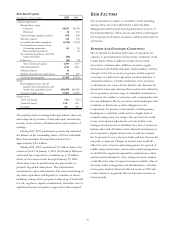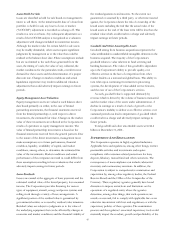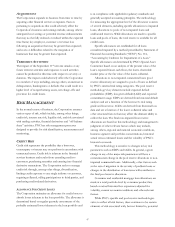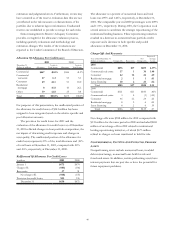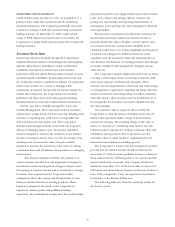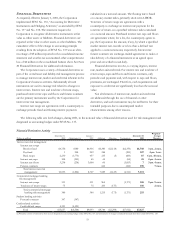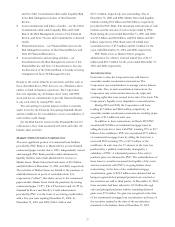PNC Bank 2001 Annual Report Download - page 49
Download and view the complete annual report
Please find page 49 of the 2001 PNC Bank annual report below. You can navigate through the pages in the report by either clicking on the pages listed below, or by using the keyword search tool below to find specific information within the annual report.47
ACQUISITIONS
The Corporation expands its business from time to time by
acquiring other financial services companies. Factors
pertaining to acquisitions that could adversely affect the
Corporation’s business and earnings include, among others:
anticipated cost savings or potential revenue enhancements
that may not be fully realized or realized within the expected
time frame; key employee, customer or revenue loss
following an acquisition that may be greater than expected;
and costs or difficulties related to the integration of
businesses that may be greater than expected.
TERRORIST ACTIVITIES
The impact of the September 11th terrorist attacks or any
future terrorist activities and responses to such activities
cannot be predicted at this time with respect to severity or
duration. The impact could adversely affect the Corporation
in a number of ways including, among others, an increase in
delinquencies, bankruptcies or defaults that could result in a
higher level of nonperforming assets, net charge-offs and
provision for credit losses.
RISK MANAGEMENT
In the normal course of business, the Corporation assumes
various types of risk, which include, among other things,
credit risk, interest rate risk, liquidity risk, and risk associated
with trading activities, financial derivatives and “off-balance
sheet” activities. PNC has risk management processes
designed to provide for risk identification, measurement and
monitoring.
CREDIT RISK
Credit risk represents the possibility that a borrower,
counterparty or insurer may not perform in accordance with
contractual terms. Credit risk is inherent in the financial
services business and results from extending credit to
customers, purchasing securities and entering into financial
derivative transactions. The Corporation seeks to manage
credit risk through, among other things, diversification,
limiting credit exposure to any single industry or customer,
requiring collateral, selling participations to third parties, and
purchasing credit-related derivatives.
ALLOWANCE FOR CREDIT LOSSES
The Corporation maintains an allowance for credit losses to
absorb losses inherent in the loan portfolio. The allowance is
determined based on regular quarterly assessments of the
probable estimated losses inherent in the loan portfolio and
is in compliance with applicable regulatory standards and
generally accepted accounting principles. The methodology
for measuring the appropriate level of the allowance consists
of several elements, including specific allocations to impaired
loans, allocations to pools of non-impaired loans and
unallocated reserves. While allocations are made to specific
loans and pools of loans, the total reserve is available for all
credit losses.
Specific allowances are established for all loans
considered impaired by a method prescribed by Statement of
Financial Accounting Standards (“SFAS”) No. 114,
“Accounting by Creditors for Impairment of a Loan.”
Specific allowances are determined by PNC’s Special Asset
Committee based on an analysis of the present value of the
loan’s expected future cash flows, the loan’s observable
market price or the fair value of the loan’s collateral.
Allocations to non-impaired commercial loans (pool
reserve allocations) are assigned to pools of loans as defined
by PNC’s internal risk rating categories. The pool reserve
methodology’s key elements include expected default
probabilities (EDP), loss given default (LGD) and expected
commitment usage. EDPs are derived from historical default
analyses and are a function of the borrower’s risk rating
grade and loan tenor. LGDs are derived from historical loss
data and are a function of the loan’s collateral value and
other structural factors that may affect the ultimate ability to
collect the loan. The final non-impaired loan reserve
allocations are based on this methodology and management’s
judgment of other relevant factors which may include,
among others, regional and national economic conditions,
business segment and portfolio concentrations, historical
actual versus estimated losses and the volatility of PNC’s
historic loss trends.
This methodology is sensitive to changes in key risk
parameters such as EDPs and LGDs. In general, a given
change in any of the major risk parameters will have a
commensurate change in the pool reserve allocations to non-
impaired commercial loans. Additionally, other factors such
as the rate of migration in the severity of problem loans or
changes in the distribution of loan tenor will contribute to
the final pool reserve allocations.
Consumer and residential mortgage loan allocations are
made at a total portfolio level by consumer product line
based on actual historical loss experience adjusted for
volatility, current economic conditions and other relevant
factors.
While PNC’s specific and pool reserve methodologies
strive to reflect all risk factors, there continues to be certain
elements of risk associated with, but not limited to, potential








